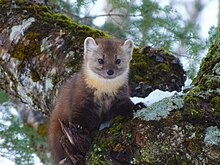Newfoundland pine marten
| Newfoundland pine marten | |
|---|---|
 |
|
| Scientific classification | |
| Kingdom: | Animalia |
| Phylum: | Chordata |
| Class: | Mammalia |
| Order: | Carnivora |
| Family: | Mustelidae |
| Genus: | Martes |
| Species: | M. americana |
| Trinomial name | |
|
Martes americana atrata (Bangs, 1897) |
|
The Newfoundland pine marten (Martes americana atrata) is a genetically distinct subspecies of the American marten (Martes americana) found only on the island of Newfoundland in the province of Newfoundland and Labrador, Canada; it is sometimes referred to as the American marten (Newfoundland population) and is one of only 14 species of land mammals native to the island. The marten was listed as endangered by the COSEWIC in 2001 and has been protected since 1934, however the population still declines. The Newfoundland marten has been geographically and reproductively isolated from the mainland marten population for 7000 years. The Newfoundland pine marten is similar in appearance to its continental cousin, but is slightly larger, with dark brown fur with an orange/yellow patch on the throat. Females are an average weight of 772 grams and males have an average weight of 1275 grams. The Newfoundland subspecies is also observed to inhabit a wider range of forest types than its mainland counterparts. The population characteristics suggest that the Newfoundland marten is a product of unique ecological setting and evolutionary selective factors acting on the isolated island population. The Newfoundland pine marten is omnivorous, feeding on mainly small mammals, along with birds, old carcasses, insects and fruits; it is currently found in suitable pockets of mature forest habitat, on the west coast of Newfoundland and in and around Terra Nova National Park. The Pine Marten Study Area (PMSA) is located in southwestern Newfoundland and is a 2078 km2 wildlife reserve that was created in 1973 to protect the Newfoundland Marten.
The Newfoundland marten range is now condensed into approximately 13,000 square kilometers in the western part of the island, with a large portion of key habitat in the Little Grand Lake area. Due to the unregulated pulpwood harvest during the last century, the forest age-class distribution is skewed to the younger regeneration stage of forest succession, which led to the majority of the island being contiguous blocks of second-growth forest. The behavioral patterns of habitat use by Newfoundland martens are altered by the ecological conditions of low prey biomass and high natural forest fragmentation that occur in Newfoundland. A wide spectrum of habitat types are used throughout the geographic range, however, it has been found the Newfoundland Marten has a strong association with old successional forest. Old-growth forest is defined as unharvested stands that are older than 80 years of age. The stand-scale habitat use includes mature coniferous forest being the dominant cover types used proportionately more than the availability, along with coniferous scrub and insect-defoliated stands used in proportion to the availability, whereas open areas and fire disturbed area are avoided. However, the fire disturbance is minimized because of the lack of prolonged dry periods on the island. Due to infrequent fires, the episodic defoliation by the spruce budworm and hemlock looper are the primary form of natural stand-replacing disturbance. Newfoundland martens have a preference to mature (61–80 years old) and over mature (>80 years old) coniferous stands since it is critical for foraging habitat. More recent studies have found that martens will use forests with a variety of height and canopy closure conditions creating a wider variety of habitat types than previously thought; this variety includes areas that are disturbed by insects, mid-successional forests, precommercially thinned forests, along with the areas of mature and overmature forests.
...
Wikipedia

